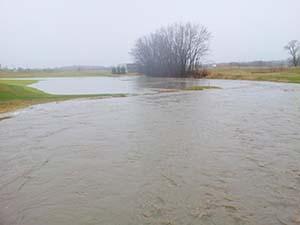 Necessity is the mother of invention, at least on some of the golf courses around Chicago.
Necessity is the mother of invention, at least on some of the golf courses around Chicago.
When a series of spring showers dumped 8 inches of rain around the city in mid-April, including 3 inches in a 24-hour period, crews at some of the courses relied on the power of teamwork to alleviate flooding. Others waited for engineering and design features to move water off the fairways. And still others, reminded of last summer's lack of rainfall that left courses throughout the Midwest parched, were thankful the back of that drought appeared to officially be broken.
"This spring was unlike any other I've gone through in recent times. It was cool, wet and constantly raining," said Matt Kregel, superintendent at The Club at Strawberry Creek in Kenosha, Wis., about one hour north of Chicago. "It was constantly raining and we couldn't get out to do much of anything, or not do it well, I should say."
Nearly 3 inches of rain fell on an already soaked Chicago area on April 17-18, leaving many courses under water, including many of the facilities operated by Billy Casper Golf.
The Vienna, Va.-based management company manages more than 20 courses throughout Illinois, including a combined 16 for the Chicago Park District and Cook County Forest Preserve. High water is nothing new at the Chicago Park District facilities that hug the shores of Lake Michigan, or the Forest Preserve facilities located in flood plains near the Des Plaines River. And the superintendents there don't wait for the water to rise before springing into action.
"Our superintendents are used to this, so they don't sit around and wait for it, they prepare for this a couple of days in advance," said Bryan Stromme, regional director of agronomy for Billy Casper Golf.
"We own a lot of pumps. But when we get rain like that we still rent them. Our superintendents are calling two days ahead of time, because if you wait you'll never get one."
The Des Plaines River features a series of locks designed to control high water in Chicago's western suburbs. Once locks open sending water downstream, the pumps go into action to clear water from the golf courses.
Billy Casper Golf also manages the Bridges of Poplar Creek Country Club, a real estate golf course in Hoffman Estates. A recent restoration project there keeps in-play areas on the golf course drier during times of excess rain while also helping to maximize flood control of Poplar Creek, which runs through the property.
Completed in accord with the U.S. Army Corps of Engineers and other local and state agencies, the restoration included raising fairways to help keep the golf course dry while also expanding the water-holding capacity of catch basins on the property. That allows the golf course to retain large amounts of water for longer periods, then releasing the water back into the creek in manageable levels to prevent flooding in the surrounding neighborhoods.
Sopped ground has been a concern at Strawberry Creek in Wisconsin as well. Cold, wet weather that included snow late into the spring left turf soaked and brown well past historic green-up time, and April's constant deluge resulted in parts of four holes under water in mid-month.
"We had all this moisture, the soil temperatures were cold, there was no sunlight. We were dormant for the longest time," Kregel said. "We were playing the waiting game for a while.
"I know the calendar says May 1, but it's more like March 1."
Kregel can't do much to change the temperature, but he is able to manage water movement off the course thanks to features installed during course construction in 2004-05.
The U.S. Army Corps of Engineers, state department of natural resources and civil engineers designed a three-phase flood control system at Strawberry Creek. That system includes several water-retention areas on the course that capture vast amounts of water during rain events to prevent flooding of nearby residential neighborhoods. A controlled-release system that includes drainage pipes of varying sizes automatically removes water from those areas as water levels in the creek that runs through the property subside. During phase 3, which was realized in April, the system automatically pulls huge amounts of water off the course after water levels in the stream have gone down and stabilized.
That means fairways that are flooded one day, often are cleared the next, leaving nothing behind but a thin layer of silt, Kregel said.
"We were flooded one day, and the next day it was gone," Kregel said. "We're lucky. Everything that backs up onto the golf course is released pretty quickly."
Sam MacKenzie, CGCS at Olympia Fields Country Club also counts himself lucky this spring.
This time last year, MacKenzie and just about every other superintendent in the Chicago area was on the brink of one of the worst droughts the Midwest has ever seen.
A little excess water when temperatures are still cool is a minor setback compared to no water and triple-digit heat, he said.
"Since February, we are at or above normal rainfall levels, and April has been double the normal amount," MacKenzie said. "That's been a good thing here. It's broken the back of the drought.
"Excessive rain is more of a positive than a negative in light of how dry we've been."

